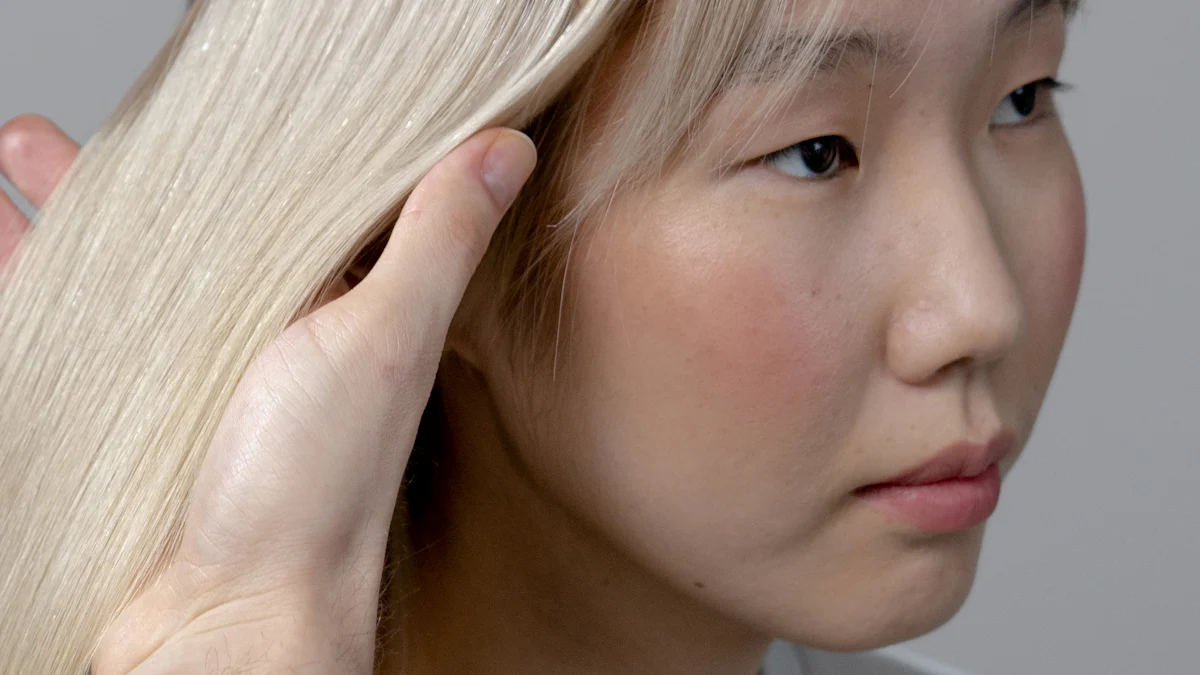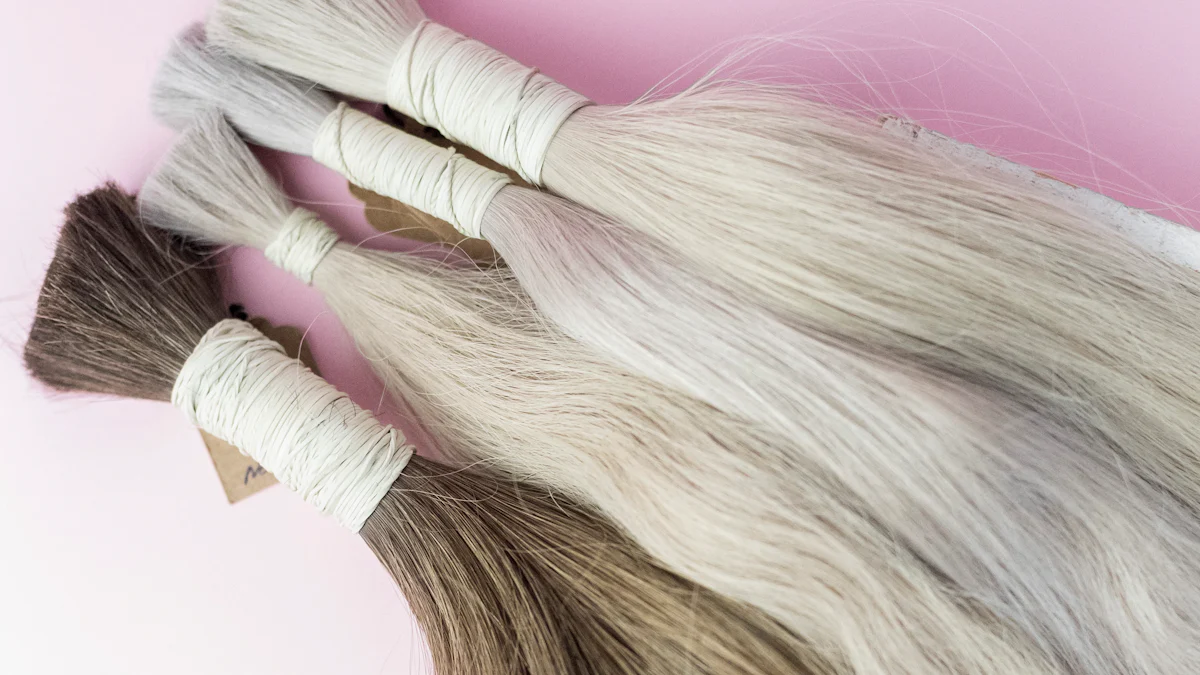Mastering Lace Front Wig Tape Application

Securing lace front wigs requires proper techniques to ensure a comfortable and secure fit. Wig caps, glue, and tape are the three main methods used for this purpose. Many prefer wig tape due to its ease of use and gentle nature on the scalp. Luvmeforyou offers high-quality lace front wig tape that provides a reliable hold without damaging natural hair or lace front wig edges. This method is faster than using glue and ensures a secure fit for any occasion.
Should I Wear a Wig Cap?

What is a Wig Cap?
Definition and Purpose
A wig cap serves as a protective barrier between natural hair and the wig. It helps keep natural hair in place and provides a smooth surface for the wig to sit on. This ensures a more secure and comfortable fit.
Benefits of Using a Wig Cap
Wearing a wig cap offers several advantages:
-
Secure Hold: Keeps natural hair securely in place, preventing it from shifting under the wig.
-
Comfort: Reduces friction between the wig and scalp, minimizing irritation.
-
Longevity: Extends the life of the wig by reducing wear and tear on the wig's interior.
-
Natural Look: Creates a smooth base, enhancing the wig's appearance.
Choosing the Right Wig Cap
Size Considerations
Selecting the correct size is crucial for comfort and security. Wig caps come in various sizes to fit different head shapes and sizes. A well-fitted wig cap should feel snug but not tight. Measure the circumference of the head to find the appropriate size.
Material Options
Wig caps are made from different materials, each offering unique benefits:
-
Nylon: Lightweight and breathable, suitable for daily wear.
-
Mesh: Offers enhanced breathability, ideal for hot climates.
-
Cotton: Soft and comfortable, perfect for sensitive scalps.
-
Silicone: Provides a non-slip grip, ensuring the wig stays in place.
Choosing the right material depends on personal preference and specific needs. For example, headband wigs feature a stretchable elastic headband for a secure fit, offering a comfortable and convenient option.
By understanding the purpose and benefits of wig caps, individuals can make informed decisions to enhance their wig-wearing experience.
Wig Glue
Understanding Wig Glue
Types of Wig Adhesives
Wig adhesives come in various forms, each offering unique benefits. Water-based adhesives provide a gentle hold and are easy to remove without leaving residue. Acrylic-based adhesives offer a stronger hold but may cause irritation for sensitive skin. Silicone-based adhesives deliver a durable bond and resist moisture, making them ideal for long-term wear.
Pros and Cons
Pros:
-
Strong Hold: Provides a secure attachment, ensuring the wig stays in place.
-
Durability: Suitable for extended wear, lasting several days to weeks.
-
Versatility: Works well with different wig types and styles.
Cons:
-
Skin Irritation: May cause discomfort or allergic reactions, especially for sensitive skin.
-
Residue Build-Up: Can leave sticky residue on the scalp and wig, requiring thorough cleaning.
-
Application Time: Takes longer to apply compared to other methods like wig tape.
Application Techniques
Preparing the Scalp
Proper scalp preparation is crucial for effective adhesive application. Start by cleaning the scalp with a suitable cleanser to remove oils, dirt, and residue. Ensure the scalp is completely dry before proceeding. This step ensures the adhesive bonds properly and provides a secure hold.
Applying the Glue
Apply a thin layer of adhesive along the hairline where the wig will sit. Use a small brush or applicator for precise application. Allow the adhesive to become tacky, which usually takes a few minutes. Avoid applying too much adhesive, as this can lead to messy application and residue build-up.
Securing the Wig
Position the lace front wig carefully over the adhesive. Press down firmly along the hairline to ensure a secure bond. Use a comb or fingers to smooth out any wrinkles or bubbles. Allow the adhesive to set completely before styling the wig. This ensures the wig remains securely in place throughout the day.
Lace Front Wig Tape

What is Wig Tape?
Definition and Benefits
Wig tape is a double-sided adhesive designed to secure lace front wigs. This tape offers a reliable hold without damaging natural hair or lace front wig edges. Many users prefer wig tape due to its ease of use and gentle nature on the scalp. Luvmeforyou provides high-quality lace front wig tape that ensures a secure fit for any occasion.
Benefits of Wig Tape:
-
Easy Application: Faster to install compared to glue, taking only several minutes.
-
Gentle on Skin: Less likely to cause irritation or allergic reactions.
-
Long-Lasting Hold: Can last up to 12 weeks with proper installation and maintenance.
-
Minimal Mess: Easier to use with little to no mess.
Comparison with Wig Glue
Wig tape and wig glue serve similar purposes but differ in several ways:
-
Installation Time: Wig tape installs faster, usually within 30-60 minutes, while glue takes longer.
-
Hold Duration: Wig tape can last up to 12 weeks, whereas glue may require more frequent reapplication.
-
Ease of Use: Wig tape is easier to apply and remove, making it less likely to damage the wig.
Selecting the Right Wig Tape
Hold Strength
Choosing the right wig tape involves considering the hold strength required. Different tapes offer varying levels of adhesion. Stronger tapes provide a more secure hold, ideal for active lifestyles or long-term wear. Weaker tapes are suitable for short-term use or those with sensitive skin.
Material and Wear Time
Wig tapes come in different materials, each offering unique benefits. Some tapes are designed for daily wear, while others are suitable for extended periods. Consider the following options:
-
Acrylic-Based Tapes: Provide a strong hold, suitable for long-term wear.
-
Silicone-Based Tapes: Offer a durable bond and resist moisture, ideal for humid climates.
-
Water-Based Tapes: Gentle on the skin, perfect for sensitive scalps.
Selecting the right material depends on personal needs and lifestyle.
Application with Tape Adhesive
Preparing the Scalp
Proper scalp preparation is crucial for effective tape adhesive application. Start by cleaning the scalp with a suitable cleanser to remove oils, dirt, and residue. Ensure the scalp is completely dry before proceeding. Clean surfaces ensure the tape adheres properly.
Applying the Tape
To apply tape adhesive, cut the tape into small strips. Place the strips along the underside of the lace front wig. Ensure the tape is near the hairline but not too close to the edge. This prevents the tape from showing through the lace front. Press down firmly to ensure the tape sticks well.
Securing the Wig
Position the lace front wig carefully over the tape adhesive. Press down along the hairline to create a secure bond with the scalp. Use a comb or fingers to smooth out any wrinkles or bubbles. Allow the tape to set completely before styling the wig. This ensures the wig remains securely in place throughout the day.
Faq about Wig Tape
Common Questions
What is the best way to apply wig tape?
Applying wig tape involves several steps. First, clean the scalp with a suitable cleanser to remove oils and dirt. Ensure the scalp is completely dry. Cut the tape into small strips and place them along the underside of the lace front wig. Press down firmly to ensure the tape sticks well. Position the wig carefully over the tape adhesive, pressing down along the hairline to create a secure bond.
How long does wig tape last?
High-quality wig tape can last up to 12 weeks with proper installation and maintenance. Lower-quality tapes may allow the wig to slip after just two weeks. The longevity depends on the type of tape and the care taken during application.
Is wig tape safe for sensitive skin?
Wig tape is generally gentler on the skin compared to wig glue. Water-based tapes are particularly suitable for sensitive scalps. Always perform a patch test before full application to ensure there is no allergic reaction.
How do I remove wig tape?
To remove wig tape, gently dab along the hairline where the tape lies using a cotton ball dipped in solvent or alcohol. This helps release the adhesion of the tape. Carefully peel off the tape to avoid damaging the lace front wig or natural hair.
Can wig tape be used with other securing methods?
Yes, wig tape can be combined with other securing methods like wig caps for added security. However, ensure that the combination does not cause discomfort or irritation.
Tips and Tricks
-
Clean Surfaces: Always start with a clean scalp. Dirt, residue, and oils can negatively affect the tape's performance.
-
Test Fit: Before applying the tape, test the fit of the wig to ensure a comfortable and secure bond with the scalp.
-
Proper Placement: Place the tape near the hairline but not too close to the edge to prevent it from showing through the lace front.
-
Firm Hold: For a firm hold, press down firmly on the tape strips to ensure they stick well.
-
Avoid Overuse: Do not use too much tape. This can lead to a bulky appearance and discomfort.
-
Maintenance: Regularly check the tape's adhesion and replace it if necessary to maintain a secure fit.
Using wig tape offers a reliable and gentle method for securing lace front wigs. By following these tips and tricks, users can achieve a comfortable and long-lasting hold.
The blog explored wig caps, glue, and tape for securing lace front wigs. Wig caps provide a smooth base for wigs and keep natural hair in place. Glue offers a strong hold but may cause irritation. Tape, such as the one from Luvmeforyou, is easy to apply and gentle on the scalp. Experimenting with these methods helps find the best fit for individual needs. Understanding various products ensures informed decisions for a comfortable and secure wig-wearing experience.






















